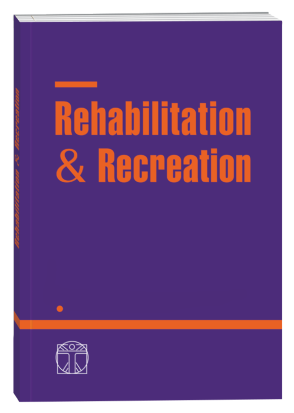ВПЛИВ СЕКЦІЙНИХ ДИХАЛЬНИХ ТЕХНІК НА ОПТИМІЗАЦІЮ ФІЗІОЛОГІЧНИХ ПОКАЗНИКІВ У СПОРТСМЕНОК
DOI:
https://doi.org/10.32782/2522-1795.2025.19.2.13Ключові слова:
секційне дихання, життєва ємність легень, частота серцевих скорочень, спортсменки, дихальні тренуванняАнотація
Передумови та мета дослідження. Секційні дихальні техніки були пов’язані з покращенням дихальної функції та серцево-судинної ефективності. Мета цього дослідження – оцінити ефективність 12-тижневого курсу секційного дихання на покращення життєвої ємності легень та зниження частоти серцевих скорочень у стані спокою серед спортсменок, які займаються спортом на регулярних тренуваннях. Матеріал та методи. Просте рандомізоване контрольоване дослідження було проведене за участю 82 спортсменок віком від 18 до 23 років, рандомізованих або до експериментальної групи (n = 41), яка практикувала секційне дихання разом з регулярними тренуваннями, або контрольної групи (n = 41), яка дотримувалася регулярних тренувань без додаткового втручання. Втручання складалося із сеансів секційного дихання під керівництвом тренера, які проводилися двічі на день (по 20 хвилин) протягом шести днів на тиждень протягом 12 тижнів. Вимірювання до і після втручання включали життєву ємність легень (у літрах) і частоту серцевих скорочень (в ударах за хвилину). Для статистичного аналізу були використані повторні вимірювання ANOVA та попарні порівняння Бонферроні. Результати. В експериментальній групі спостерігалося значне збільшення середньої життєвої ємності легень з 3,008 л (±0,287) до 3,156 л (±0,305), що підтверджується великим розміром ефекту (F = 448,397, p = .000, η² = .847). Аналогічно частота серцевих скорочень значно знизилася з 55,207 уд/хв (±6,204) до 49,951 уд/хв (±5,906) (F = 246,097, p = .000, η² = .752). Парні порівняння підтвердили статистично значущі відмінності між показниками до і після втручання для обох результатів. Висновки. Отримані результати демонструють, що секційне дихання є ефективною та економічною стратегією для покращення функції легень та підвищення серцево-судинної ефективності у спортсменок. Включення таких дихальних тренувань у регулярні спортивні програми може мати вимірні переваги для здоров’я та продуктивності.
Посилання
1. Bucea-Manea-Țoniș, R., Paun, D.G., Mindrescu, V., Cătună, C. (2023). Yoga, an appurtenant method to improve the sports performance of elite Romanian athletes. Sustainability, 15(5), 4264. https://doi.org/10.3390/su15054264
2. De Couck, M., Caers, R., Musch, L., Fliegauf, J., Giangreco, A., Gidron, Y. (2019). How breathing can help you make better decisions: Two studies on the effects of breathing patterns on heart rate variability and decisionmaking in business cases. International Journal of Psychophysiology, 139, 1–9. https://doi.org/10.1016/j.ijpsycho.2019.02.011
3. Du, Y., Jiang, K., Li, H. (2024). A respiratory sensor-based study of the relationship between voluntary breathing patterns and aerobic and anaerobic exercise capacity: An exploratory applied study. Sensors, 24(19), 6310. https://doi.org/10.3390/s24196310
4. Goswami, K., Sao, A.K. (2024). Effects of yoga practice on cardiovascular & respiratory parameters in professional athletes. Indian Journal of YOGA Exercise & Sport Science and Physical Education, 35–40. https://doi.org/10.58914/ijyesspe.2024-9.2.5
5. Hakked, C.S., Balakrishnan, R., Krishnamurthy, M.N. (2017). Yogic breathing practices improve lung functions of competitive young swimmers. Journal of Ayurveda and Integrative Medicine, 8(2), 99–104. https://doi.org/10.1016/j.jaim.2016.12.005
6. Harbour, E., Stöggl, T., Schwameder, H., Finkenzeller, T. (2022). Breath tools: A synthesis of evidence-based breathing strategies to enhance human running. Frontiers in Physiology, 13, 813243. https://doi.org/10.3389/fphys.2022.813243
7. Jayachitra, M. (2012). Effect of pranayama and bandha practices on selected physiological variables among adolescent girls. International Journal of Physical Education and Sports Management, 1(10), 17. https://www.researchgate.net/publication/253340909
8. Jimenez Morgan, S., Molina Mora, J.A. (2017). Effect of heart rate variability biofeedback on sport performance: A systematic review. Applied Psychophysiology and Biofeedback, 42, 235–245. https://doi.org/10.1007/s10484-017-9364-2
9. Lehrer, P., Kaur, K., Sharma, A., Shah, K., Huseby, R., Bhavsar, J., Zhang, Y. (2020). Heart rate variability biofeedback improves emotional and physical health and performance: A systematic review and meta-analysis. Applied Psychophysiology and Biofeedback, 45, 109–129. https://doi.org/10.1007/s10484-020-09466-z
10. Manna, I. (2019). Study the influence of yoga on body composition and cardio-pulmonary functions on healthy female volunteers. International Journal of Physiology, 4, 106–110. Retrieved from: https://www.journalofsports.com/pdf/2019/vol4issue2/PartC/4-1-370-758.pdf
11. Manna, I., Chowdhury, M. (2020). Effects of 12 weeks yoga practice on body composition and cardiopulmonary status of 10–12 years female volunteers. Archives of Medicine and Health Sciences, 8(2), 208–214. https://doi.org/10.4103/amhs.amhs_143_19
12. Munadi, M., Suhanda, R., Zulkarnain, Z., Azhari, M., Yulia, W. (2024). Optimization of lung vital capacity to improve athlete fitness. Journal of Social Research, 3(4), 1010–1017. https://doi.org/10.55324/josr.v3i4.1988
13. Rathod, K., Sawaliya, J.K., Panchal, D., Rathod, T., Patel, V. (2024). Effect of pranayama on competitive state anxiety among male basketball players. Yogic Approaches to Mental Health, 1(1), 27–42. https://doi.org/10.47413/vidya.v3i2.482
14. Sanjaykumar, S., Rajkumar, N.C.J., Lakshmi, P.Y. (2023). Impact of varied temperature living conditions, stress levels, and sleeping duration on oligomenorrhea: A comprehensive study among women. Physical Rehabilitation and Recreational Health Technologies, 8(4), 183–187. https://doi.org/10.15391/prrht.2023-8(4).02
15. Sanjaykumar, S., Rajkumar, N.C.J., Lakshmi, P.Y. (2024). The effects of psychological interventions on menstrual health in exercising women: A comprehensive experimental study. Physical Rehabilitation and Recreational Health Technologies, 9(2), 45–51. https://doi.org/10.15391/prrht.2024-9(2).01
16. Sanjaykumar, S., Rajkumar, N.C.J., Lakshmi, P.Y., Salini, B., Boby, F.A., Kurnaz, M. (2024). Assessing the effect of exercise timing on menstrual irregularity in women diagnosed with oligomenorrhea. Health, Sport, Rehabilitation, 10(4), 74–84. https://doi.org/10.58962/HSR.2024.10.4.74-84
17. Schober, P.D. (2018). The introduction of yoga recovery on physiological and psychological stress and performance in NCAA athletes: Master’s thesis, University of Montana. ScholarWorks. Retrieved from: https://scholarworks.umt.edu/cgi/viewcontent.cgi?article=12192&context=etd
18. Solikhin, M.N., Sumaryanti, Sulistiyono, Fauzi, Arbanto, B. (2024). Benefit of breathholding training on the concept of recreational freediving in healthy adults: A systematic literature review. Fizjoterapia Polska, 24(1), 199–204. https://doi.org/10.56984/8ZG2EF8z2j
19. Strakolyst, H.M., Bohdanovska, N.V., Bessarabova, O.V. (2023). The influence of diaphragm breathing on the state of the vessel endothelium in young women with essential hypertension. Rehabilitation and Recreation, 15, 111–117. https://doi.org/10.32782/2522-1795.2023.15.14
20. Thakare, V. (2021). Pranayama for enhancing respiratory and cardiovascular function. Ashok Yakkaldevi. ISBN: 978-1-6780-2626-4
21. Verma, A., Balekar, N., Rai, A. (2024). Navigating the physical and mental landscape of cardio, aerobic, Zumba, and yoga. Archives of Medicine and Health Sciences, 12(2), 242–250. https://doi.org/10.4103/amhs.amhs_20_24
##submission.downloads##
Опубліковано
Як цитувати
Номер
Розділ
Ліцензія

Ця робота ліцензується відповідно до Creative Commons Attribution-NonCommercial-NoDerivatives 4.0 International License.





